Three years into a study of deer in Southwest Washington, state biologist Eric Holman is confirming the expected — blacktails live in a very small home range.
How small? Well, the average is 1/20th of a square mile.
Some of his collared does might move a bit, often in response to snowfall or other weather.
“Most live in tiny home ranges,” he said.
But that’s most, not all.
Holman’s got one doe that likes to travel about the forest.
He captured the deer in March east of Hockinson on forest land managed by the state Department of Natural Resources, where she lived in March and April.
Come May, the doe moved about eight miles to Weyerhaeuser Co. land in the Yacolt Burn north of the East Fork of the Lewis River.
Then, three days prior to giving birth, she moved another 10 miles east into the Gifford Pinchot National Forest near Trapper Creek Wilderness to reside in a stand of old-growth.
She spent the summer there.
In September, the deer followed almost the exact same path back to the Weyerhaeuser land in Yacolt Burn.
“The magic of these (GPS) collars is it allows you to look at things like this,” said Holman, district wildlife biologist for the Department of Fish and Wildlife. “I had suspected some of these westside deer do that (move), but without marked animals you don’t have the science behind it to prove it.”
Deer in Klickitat County are known to spend their summers on Mount Adams and in the Simcoe range, but westside deer are thought to be mostly stay-at-home animals.
Holman’s wandering doe is part of a Western Washington deer study started in 2009, expanded to the Washougal game unit in 2010 and the Coweeman area in 2012.
The research is trying to ascertain if differences in forest management methods have an impact in the ecology of blacktail deer.
Overall, 29 does throughout Western Washington were captured in 2009-11 and they gave birth to 48 fawns, 11 of which survived one year. The does and fawns are fitted with GPS collars so the state can monitor them. The does also are given vaginal transmitters, which send a signal when the animal gives birth.
That signal sends Holman and others in the research teams scrambling during the fawning season.
“It’s an adventure,” Holman said. “It’s enjoyable but it’s hard, it’s weekends and it’s odd hours.”
The fawns do not move much for their first 12 to 24 hours.
“There’s a huge advantage getting to go right where the fawns were born,” he said. “After about a week and half, you can’t catch them. They are so mobile they’ll get up and run away.”
Actually, the best fawn-catching strategy is to flush the doe away and then search, he said.
Holman said it is early in the study, but the 24 percent survival rate to age 1 is lower than he expected.
“We know going into this study that mortality on these neo-natals — the brand new young of the year — is always going to be very high,” he said. “All they can really do for the first week or two of life is hide and nurse and try to grow up. They’re really vulnerable at that time. If I can catch one of these things something built to do it certainly can.”
So far, the research demonstrates the importance of different types of forest habitat for deer.
“All the does used multiple types of forest stands, no matter what their home range, no matter how small it was, they all use multiple kinds of habitat,” Holman said.
The favorite habitat were lands logged 5 to 10 years ago with a strong shrub component. Shrubs are groceries for deer.
“Part of the study design is to try to assess the impacts herbicide applications might have on the quality of the habitat,” he said. “It does look like that probably has something to do with it. The more aggressive herbicide application degrades the deer habitat basically.”
Herbicide applications are not done just by private foresters. The Washington Department of Natural Resources also uses them.
Different companies, even different individual foresters, will manage their lands with different chemicals, application rates and treatments, he said.
“Herbicides really came on as a result of the clean air restrictions that disallowed burning of slash and brush in forest plantations,” Holman said. “It was primarily an industry response to their inability to use extensive burning as a tool.”
Holman said predator control is often suggested by hunters as a away to boost big game populations.
“Coyotes, cougars, bobcats, bears are absolutely eating these fawns,” he said. “That’s how they make a living. We knew that would happen.”
Predator control tends not to be a solution, he added.
“Predators don’t wipe out their prey populations or they wouldn’t have anything to eat,” he said. “Most studies of predator control efforts arrive at the conclusion that your population is much more fundamentally based on the quality of habitat.”
Does live 10 to 12 years, often giving birth to twin fawns annually.
“So, if she reproduces herself and a buck some time during her life that population is stable,” Holman said. “These young are kind of expendable. It’s the adult females that are really important to the population.”
He also said the three-year-old study is designed to go another five to seven years.
“All these numbers are little,” Holman said. “A real weakness is when your sample size is so low one or two things happen and it seems like that is what is happening overall. That’s a dangerous thing to do. You don’t want to draw conclusions from a small sample size.”




